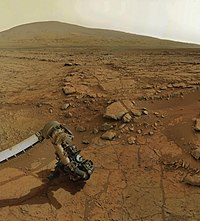
Geomorphologic Characteristics of Polygonal Features on Chloride-Bearing Deposits on Mars: Implications for Martian Hydrology and Astrobiology
Sign Up to like & getrecommendations! Published in 2019 at "Journal of Earth Science"
DOI: 10.1007/s12583-019-1212-2
Abstract: Over 600 chloride-bearing deposits (chlorides) have been identified on the southern highlands of Mars. These chlorides have critical implications for hydrology and astrobiology: they are indicators of an evaporating super saturated solution, and they could… read more here.
Keywords: astrobiology; hydrology; polygonal features; chloride bearing ... See more keywords

Organism-substrate interactions and astrobiology: Potential, models and methods
Sign Up to like & getrecommendations! Published in 2017 at "Earth-Science Reviews"
DOI: 10.1016/j.earscirev.2017.05.009
Abstract: Abstract Organism-substrate interactions and their products – biogenic structures – are important biosignatures on Earth. This study discusses the application of ichnology – the study of organism-substrate interactions – to the search for present and… read more here.
Keywords: astrobiology; biogenic structures; beyond earth; organism substrate ... See more keywords

The maximum growth rate of life on Earth
Sign Up to like & getrecommendations! Published in 2017 at "International Journal of Astrobiology"
DOI: 10.1017/s1473550416000501
Abstract: Abstract Life on Earth spans a range of temperatures and exhibits biological growth rates that are temperature dependent. While the observation that growth rates are temperature dependent is well known, we have recently shown that… read more here.
Keywords: astrobiology; life; life earth; rate ... See more keywords

Anaerobic microorganisms in astrobiological analogue environments: from field site to culture collection
Sign Up to like & getrecommendations! Published in 2017 at "International Journal of Astrobiology"
DOI: 10.1017/s1473550417000246
Abstract: Abstract Astrobiology seeks to understand the limits of life and to determine the physiology of organisms in order to better assess the habitability of other worlds. To successfully achieve these goals we require microorganisms from… read more here.
Keywords: anaerobic microorganisms; astrobiology; field; culture collection ... See more keywords

Extraction of amino acids using supercritical carbon dioxide for in situ astrobiological applications
Sign Up to like & getrecommendations! Published in 2018 at "International Journal of Astrobiology"
DOI: 10.1017/s147355041800006x
Abstract: Abstract The detection of organic molecules that are indicative of past or present biological activity within the Solar System bodies and beyond is a key research area in astrobiology. Mars is of particular interest in… read more here.
Keywords: extraction; astrobiology; amino acids; water ... See more keywords

Phytoclimatic mapping of exoplanets
Sign Up to like & getrecommendations! Published in 2019 at "International Journal of Astrobiology"
DOI: 10.1017/s1473550419000181
Abstract: Abstract The concept of exoplanetary habitability is evolving. The driving force is a desire to define the biological potential of planets and identify which can host complex and possibly intelligent life. To assess this in… read more here.
Keywords: astrobiology; biological potential; phytoclimatic mapping; mapping exoplanets ... See more keywords

Photosynthesis on exoplanets and exomoons from reflected light
Sign Up to like & getrecommendations! Published in 2019 at "International Journal of Astrobiology"
DOI: 10.1017/s1473550419000247
Abstract: Abstract Photosynthesis offers a convenient means of sustaining biospheres. We quantify the constraints for photosynthesis to be functional on the permanent nightside of tidally locked rocky exoplanets via reflected light from their exomoons. We show… read more here.
Keywords: astrobiology; reflected light; exoplanets exomoons; exomoons reflected ... See more keywords

The interstellar communication relay
Sign Up to like & getrecommendations! Published in 2020 at "International Journal of Astrobiology"
DOI: 10.1017/s1473550420000178
Abstract: Abstract The paper describes the architecture for a data repository and distribution system to be used in the case of a SETI detection event. This system is conceptually modelled after the Deep Space Network, although… read more here.
Keywords: astrobiology; system; communication relay; interstellar communication ... See more keywords

Reaching out to early-career astrobiologists: AbGradE's actions and perspectives
Sign Up to like & getrecommendations! Published in 2022 at "International Journal of Astrobiology"
DOI: 10.1017/s1473550422000040
Abstract: Astrobiology Graduates in Europe (AbGradE, pronounced ab-grad-ee) is an association of early-career scientists working in fields relevant to astrobiological research. Conceptualized in 2013, it was initially designed as a mini-conference or workshop dedicated to early-career… read more here.
Keywords: astrobiology; reaching early; career; astrobiologists abgrade ... See more keywords

Astrovirology: how viruses enhance our understanding of life in the Universe
Sign Up to like & getrecommendations! Published in 2023 at "International Journal of Astrobiology"
DOI: 10.1017/s1473550423000058
Abstract: Viruses are the most numerically abundant biological entities on Earth. As ubiquitous replicators of molecular information and agents of community change, viruses have potent effects on the life on Earth, and may play a critical… read more here.
Keywords: support systems; astrobiology; earth; understanding life ... See more keywords

G-Equivalent Acceleration Tolerance in the Eutardigrade Species Hypsibius dujardini.
Sign Up to like & getrecommendations! Published in 2017 at "Astrobiology"
DOI: 10.1089/ast.2015.1439
Abstract: Tardigrades are microscopic organisms renowned for their ability to survive extreme environmental conditions. Tardigrade extreme-tolerance research has centered on the ability to withstand desiccation, low and high temperatures, and high hydrostatic pressure and radiation levels.… read more here.
Keywords: hypsibius dujardini; astrobiology; species hypsibius; tolerance ... See more keywords